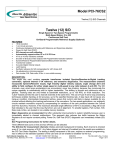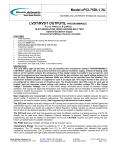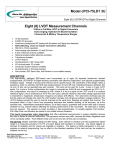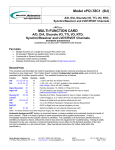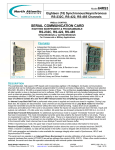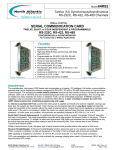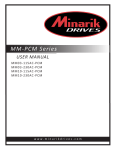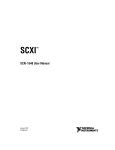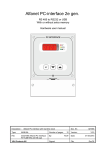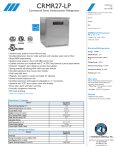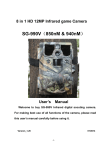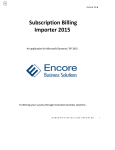Download rtX PCI 76CL1-006CLA-05
Transcript
Model PCI-76CL1 Eight (8) LVDT/RVDT-to-Digital and Six (6) Digital-to-LVDT/RVDT Channels Eight (8) LVDT/RVDT Measurement Channels Eight (8) 2-Wire or 3/4-Wire to Digital Converters, and Six (6) LVDT/RVDT Stimulus Channels Six (6) 3/4-Wire or Twelve (12) 2-Wire, Programmable 16 BIT RESOLUTION; WRAP-AROUND SELF TEST Optional Excitation Supply Commercial & Military Versions Available FEATURES: • • • • • • • • • • • • • • • 16 Bit Resolution Continuous background BIT testing with Excitation and Signal loss detection Automatically supports either 5V or 3.3V PCI bus Transformer isolated 4, 8 and 12 (2 wire) Stimulus channels or 2, 4 and 6 (3 or 4 wire) Stimulus channels available to Mix with 4 or 8 (2, 3, or 4 wire) Measurement channels Auto-ranging input between 2.0 and 28 Vrms Self-calibrating. Card removal NOT required. 360 Hz to 10 kHz operation LATCH feature for Measurement ON/OFF for Stimulus (D/L) Channels Stable output with temperature Watchdog timer and soft reset No adjustments or trimming required Commercial or Extended Temperature Part number, S/N, Date code, & Rev. in nonvolatile memory DESCRIPTION: This single slot high density intelligent DSP-based card offers up to eight (8) separate transformer isolated programmable LVDT/RVDT-to-Digital tracking converters and up to twelve (12) two-wire, or six (6) three/four-wire transformer isolated “PROGRAMMABLE” LVDT/RVDT outputs and all with wrap-around self-test and optional excitation supply. Instead of buying cards that are set for specific outputs or inputs, the uniqueness of this design makes it possible to buy our combination measurement and stimulus channels whose outputs can be programmed and reprogrammed in the field for any excitation and signal voltage between 2.0 and 28 volts and whose measurement inputs can auto range between 2.0 and 28 volts. Operating frequency between 360Hz and 10 kHz can be specified (see Part Number). This card can be configured for either two-wire or three/four-wire LVDTs. The measurement channels of this card can be used for 4-wire, 3-wire or 2-wire LVDT inputs. For 4-wire or 3-wire configurations the output is computed as A-B/A+B and is expressed as %FS. For 2-wire configurations, the output is computed as A/B (where A is the a-b signal of the LVDT and B is a constant reference signal) and is expressed as %FS This card uses a derived reference ratio-metric design approach that is insensitive to magnitude, temperature, frequency and phase shift effects. The ratio-metric technique assures that the output will change only when the LVDT position changes and will ignore excitation voltage variations. The LATCH feature permits the user to read all channels at the same time. Reading will unlatch that channel. The converters utilize a Type II servo loop processing technique that enables tracking, at full accuracy, up to the specified rate. Intermediate transparent latches, on all data outputs, Apex Signal Division North Atlantic Industries, Inc. 110 Wilbur Place, Bohemia, NY 11716 631.567.1100/631.567.1823 (fax) www.naii.com / e-mail:[email protected] 9/5/03 Cage Code:OVGU1 76_CL1_A001_Rev_2.3 Page 1 of 17 guarantee that current valid data is always available for any channel without affecting the tracking performance of the converters. No interrupts or waiting time are required. For each Stimulus channel, one transformer isolated excitation is supplied for each A, B output pair. The transformation ratio (TR), same for each pair of outputs, sets the maximum output voltage with relation to the excitation voltage (TR = Max Output Voltage / Excitation Voltage). Use of a ratio-metric design eliminates errors caused by excitation voltage variations. The outputs are stable with temperature and switching spikes are not noticeable. A watchdog timer is provided to monitor the processor. To simplify logistics, Part number, S/N, Date code, & Rev. are located in nonvolatile memory locations. Major diagnostics are incorporated to offer substantial improvements to system reliability because the user is alerted (within 5 seconds) to channel malfunctions. This approach reduces bus traffic because the Status registers do not require constant polling. See Programming Instructions for further details. The D2 test initiates automatic background BIT testing that for measurement, each channel is checked over the programmed signal range to a measuring accuracy 0.1% FS. For stimulus, background BIT testing compares the output of each channel against the commanded input to a test accuracy of 0.2% FS. BIT also monitors each Signal Output and Excitation. A failure triggers an Interrupt (if enabled) and results are available in Status Registers. Testing, requires no external programming, has no effect on the standard operation of this card and can be enabled or disabled via the bus. The D3 test for measurement starts an initiated BIT Test that disconnects all channels from the outside world and connects them across an internal stimulus that generates and measures multiple voltages to a test accuracy of 0.1%FS. External excitation for measurement channels is not required. The (D3) test for stimulus channels starts a BIT test that generates and tests 20 different positions to a testing accuracy of 0.2% FS. External reference is required. CAUTION: (Stimulus channel) Outputs are active during this test. In any case, testing requires no external programming, and can be Initiated or terminated via the bus. Check connected loads for possible interaction. Any failure triggers an interrupt (if enabled) and results can be read from the Status Registers. The D0 test is used to check the card and the PCI interface. All channels are disconnected from the outside world, allowing user to write any number of input positions to the card and then read the data from the interface. The D0 Test only applies to the Measurement channels. External excitation is not required. Temperature Range: This board is available for "C" or "E" operating temperature ranges (See part number designation). The "C" version operates from 0°C to +70°C and is populated with standard high quality commercial semiconductors. The "E" version, used for severe environmental condition, operates from -40°C to +85°C and is populated with high quality extended temperature semiconductors. SPECIFICATIONS: Number of channels: Resolution: Accuracy: Bandwidth: Input format: Input voltage Excitation voltage: Input Impedance: Frequency: Phase shift: Wrap around Self Test: SPECIFICATIONS: Number of channels: Resolution: Linearity: Output Format: Load: (For each Measurement channel) 4 or 8. See part number. 16-bit 0.025% FS 40 Hz. BW and tracking rate can easily be customized. 2, 3, or 4-wire LVDT or RVDT Auto-ranging from 2.0 to 28 Vrms. Transformer isolated. Not required for computation of output but should be connected to allow card to check for excitation loss. 40 kΩ min. at 360 Hz Specify between 360 Hz to 10 kHz, (See Part Number and Code Table) Automatically compensates for phase shifts between the transducer excitation and Output up to ±60° (3-wire units ignore phase shift) Three powerful test methods are described in the Programming Instructions. (For each Stimulus channel) 4, 8 or 12 (2-Wire), or 2, 4 or 6 (3/4-Wire). See part number. 16 bits (.001526% FS) 0.1%FS for .2 <= TR <= 2.0 (.05% FS available at a specified frequency and TR) Configurable for either 3/4-wire or 2-wire transformer isolated. Output voltage will vary directly with excitation. With output voltages from 2.0 to 20.0Vrms: 10 kΩ min. Apex Signal Division North Atlantic Industries, Inc. 110 Wilbur Place, Bohemia, NY 11716 631.567.1100/631.567.1823 (fax) www.naii.com / e-mail:[email protected] 9/5/03 Cage Code:OVGU1 76_CL1_A001_Rev_2.3 Page 2 of 17 With output voltages from 20 to 28.0Vrms: 15 kΩ min. Short circuit protected. Regulation: 2% max. Excitation: 2.0 to 28 Vrms. Transformer isolated. Frequency (excitation): 360 Hz to 10kHz, see code table Phase Shift (input to output):3° max Phase shift (A/B): 0.5°. Excitation (each) Z in: 50 KΩ min. Signal Logic Level: Automatically supports either 5V or 3.3V PCI bus Power: +5 VDC ±5% at 0.35 A + 1A ( 3A peak ) @ 5VA Load on optional Excitation Supply ±12 VDC ±5% at 0.5 A EXCITATION: Voltage: Frequency: Regulation: Output power: Optional. (See part number). 2.0–28 Vrms or 115 Vrms fixed; resolution 0.1 Vrms; Accuracy ±2% 360 Hz to 10 kHz ±1% with 1 Hz resolution. 10% max. No load to full load. 5VA max. @ 40° min. inductive; 190mA RMS @ 2-26VAC, 45mA RMS @ 115VAC Note: Power is reduced linearly as the Excitation Voltage decreases. GENERAL SPECIFICATIONS: Signal Logic Level: Power: Temperature, operating: Temperature, storage: Size: Weight: Automatically supports either 5V or 3.3V PCI bus. See current requirement Table 1 below. Power supplies must be able to supply the peak power without current limiting. “C” = 0°C to +70°C, “E” = -40°C to +85°C (See part number) -55° C to +105° C 3.950 (10.033) height, 12.285 (31.204) length; less front panel connector J1; dimensioned in inches (cm) Board & heat sink less modules 10 oz. Max. L/D modules @ 4 Ch ea. 2.5 oz. Max. D/L modules w/ transformers 2Ch ea. 5.0 oz. Max. Excitation module 1.8 oz. Max. CURRENT REQUIREMENTS: Board – no Modules Add per 4 Ch L/D Mod Add per 2 Ch D/L Mod ±12Vdc 15mA 15mA 140mA Excitation Module +5Vdc 460mA 160mA 35mA 1A @ 5VA Load (3A Peak) TABLE 1 Apex Signal Division North Atlantic Industries, Inc. 110 Wilbur Place, Bohemia, NY 11716 631.567.1100/631.567.1823 (fax) www.naii.com / e-mail:[email protected] 9/5/03 Cage Code:OVGU1 76_CL1_A001_Rev_2.3 Page 3 of 17 Principal of Operation (LVDT): Typically the primary is excited by an ac source, causing a magnetic flux to be generated within the transducer. Voltages are induced in the two secondaries, with the magnitude varying with the position of the core. Usually, the secondaries are connected in series opposition, causing a net output voltage of zero when the core is at the electrical center. When the core is displaced in either direction from center the voltage increases linearly either in phase or out of phase with the excitation depending on the direction. EXCITATION A = Va B = Vb 2 WIRE (2 CHANNEL) OR A = Va-Vb EXCITATION 2 WIRE (1 CHANNEL) (IN-PHASE) 10.0 V B = Va-Vb (USUAL LVDT CONFIGURATION) Example uses 10Vrms output Vb 5.0 V Va 4 WIRE 3 WIRE B = Vb A = Va EXCITATION EXCITATION 0.0 V A = Va B = Vb POSITION -FS O +FS Va+Vb=10V Va+Vb=10V Va-Vb=10V Va-Vb=0V Va=0V Va=5V Vb=10V Vb=5V Va+Vb=10V Va-Vb=10V Va=10V Vb=0V POSITION = (Va-Vb) / (Va+Vb) Apex Signal Division North Atlantic Industries, Inc. 110 Wilbur Place, Bohemia, NY 11716 631.567.1100/631.567.1823 (fax) www.naii.com / e-mail:[email protected] 9/5/03 Cage Code:OVGU1 76_CL1_A001_Rev_2.3 Page 4 of 17 OPTIONAL ON BOARD EXCITATION OPTIONAL ON BOARD EXCITATION 4 Wire 3 Wire A HI A HI a a A LO A LO B LO Excitation IN Excitation IN B LO b b B HI B HI POS = a - b a+b POS = a - b a+b Excitation Ref Hi (Monitoring) Excitation Ref Lo Excitation Ref Hi (Monitoring) Excitation Ref Lo OPTIONAL ON BOARD EXCITATION 2 Wire A HI a-b A LO a Excitation IN POS = a - b Excit. b B HI B LO Excitation Ref Hi (Monitoring) Excitation Ref Lo Interfacing the LVDT to the Converter for Measurement: Two common connection methods are: 1. Primary as reference (two-wire system) This method of connection converts the widest range of LVDT sensors and is the most sensitive to excitation voltage variations, temperature and phase shift effects. 2. Derived reference (three/four-wire LVDT) The LVDT is again excited from the primary side, but the converter reference is the sum of A + B that has constant amplitude for changing core displacement. This system is insensitive to temperature effects, phase shifts and oscillator instability and solves the identity (A-B)/(A+B) Configuring Stimulus Channels for 2 and 3/4-Wire Outputs: When referring to the register map make note that there are references made to channels 1A & B through 4A & B. For channels programmed for 3/4-wire mode, the A&B Position Data Registers are shared. Therefore, only Position Data Register A is set when configuring the registers. The card can be programmed for use in combination, but as previously stated, the 3/4-wire channels are paired off with the same number channel A & B and cannot be separated. Channels programmed for 2-wire mode, the A & B outputs are set individually allowing for up to a total of 8 separate output channels. I.e., the output Ch1 A will produce a voltage equivalent to the Va-Vb voltage of a 2 wire system representing the Position in Ch 1 A Data Register, and Ch1 B will produce the equivalent voltage representing the Position in Ch1 B Data Register. Apex Signal Division North Atlantic Industries, Inc. 110 Wilbur Place, Bohemia, NY 11716 631.567.1100/631.567.1823 (fax) www.naii.com / e-mail:[email protected] 9/5/03 Cage Code:OVGU1 76_CL1_A001_Rev_2.3 Page 5 of 17 PROGRAMMING INSTRUCTIONS: MEMORY MAP 000 004 008 00C 010 014 018 01C 020 024 028 02C 030 034 038 03C 040 044 048 04C 050 054 058 05C 060 064 068 06C 070 074 078 07C 080 084 088 08C 090 094 098 09C L/D Ch.1 Data L/D Ch.2 Data L/D Ch.3 Data L/D Ch.4 Data L/D Ch.5 Data L/D Ch.6 Data L/D Ch.7 Data L/D Ch.8 Data L/D Velocity Ch. 1 L/D Velocity Ch. 2 L/D Velocity Ch. 3 L/D Velocity Ch. 4 L/D Velocity Ch. 5 L/D Velocity Ch. 6 L/D Velocity Ch. 7 L/D Velocity Ch. 8 Scale Ch.1 Scale Ch.2 Scale Ch.3 Scale Ch.4 Scale Ch.5 Scale Ch.6 Scale Ch.7 Scale Ch.8 Active channels L/D Test (D2) verify L/D Test Enable L/D Status, Signal L/D Status,Excitation L/D Status,Test L/D Latch LVDT/D Test Position 2-3/4 Wire Mode (A&B) resolution Ch. 1 (A&B) resolution Ch. 2 (A&B) resolution Ch. 3 (A&B) resolution Ch. 4 (A&B) resolution Ch. 5 (A&B) resolution Ch. 6 (A&B) resolution Ch. 7 read read read read read read read read read read read read read read read read read/write read/write read/write read/write read/write read/write read/write read/write read/write read/write read/write read read read write read/write read/write read/write read/write read/write read/write read/write read/write read/write Apex Signal Division North Atlantic Industries, Inc. 110 Wilbur Place, Bohemia, NY 11716 0A0 0A4 0A8 0AC 0B0 0B4 0B8 0BC 0C0 0C4 0C8 0CC 0D0 0D4 0D8 0DC 0E0 0E4 0E8 0EC 0F0 0F4 0F8 0FC 100 104 108 10C 110 114 118 11C 120 124 128 12C 130 134 138 13C (A&B) resolution Ch. 8 Velocity Scale Ch. 1 Velocity Scale Ch. 2 Velocity Scale Ch. 3 Velocity Scale Ch. 4 Velocity Scale Ch. 5 Velocity Scale Ch. 6 Velocity Scale Ch. 7 Velocity Scale Ch. 8 Magnitude (A+B) Ch.1 Magnitude (A+B) Ch.2 Magnitude (A+B) Ch.3 Magnitude (A+B) Ch.4 Magnitude (A+B) Ch.5 Magnitude (A+B) Ch.6 Magnitude (A+B) Ch.7 Magnitude (A+B) Ch.8 Position Ch. 1A Data Position Ch. 1B Data (2-wire) Position Ch. 2A Data Position Ch. 2B Data (2-wire) Position Ch. 3A Data Position Ch. 3B Data (2-wire) Position Ch. 4A Data Position Ch. 4B Data (2-wire) Position Ch. 5A Data Position Ch. 5B Data (2-wire) Position Ch. 6A Data Position Ch. 6B Data (2-wire) Transformer Ratio Ch. 1 Transformer Ratio Ch. 2 Transformer Ratio Ch. 3 Transformer Ratio Ch. 4 Transformer Ratio Ch. 5 Transformer Ratio Ch. 6 Wrap-around D/L Ch.1A Wrap-around D/L Ch.1B Wrap-around D/L Ch.2A Wrap-around D/L Ch.2B Wrap-around D/L Ch.3A 631.567.1100/631.567.1823 (fax) www.naii.com / e-mail:[email protected] read/write read/write read/write read/write read/write read/write read/write read/write read/write read/write read/write read/write read/write read/write read/write read/write read/write read/write read/write read/write read/write read/write read/write read/write read/write read/write read/write read/write read/write read/write read/write read/write read/write read/write read/write read read read read read 140 144 148 14C 150 154 158 19C 1A0 1A4 1A8 1AC 1B0 1B4 1B8 1BC 1C0 1C4 1C8 1CC 1D0 1D4 1D8 1DC 1E0 1E4 1E8 1EC 1F0 1F4 1F8 Wrap-around D/L Ch.3B Wrap-around D/L Ch.4A Wrap-around D/L Ch.4B Wrap-around D/L Ch.5A Wrap-around D/L Ch.5B Wrap-around D/L Ch.6A Wrap-around D/L Ch.6B 2-3/4 Wire Mode D/L Status, Signal D/L Status,Excitation D/L Status,Test D/L Active channels D/L Test (D2) verify D/L Test Enable D/L Outputs ON/OFF Interrupt Enable Interrupt Status Frequency (Exc. Supply) Voltage (Exc. Supply) Watchdog timer Soft reset Part # Serial # Date code Rev level PCB Rev level DSP Master Rev level FPGA Master Rev level DSP Slave Rev level FPGA Slave Rev level Interface FPGA Board Ready 9/5/03 Cage Code:OVGU1 read read read read read read read read/write read read read read/write read/write read/write read/write read read/write read/write read/write read/write write read read read read read read read read read read 76_CL1_A001_Rev_2.3 Page 6 of 17 REGISTER BIT MAP Latch Outputs Test Enable L/D Active channels L/D Status, Test L/D Status, Signal L/D Status, Excitation L/D 2 or 3,4 wire Input L/D Test Enable D/L Active channels D/L Outputs ON/OFF Status, Test D/L 2 Status, Signal D/L Status, Excitation D/L 3 2 or 3,4 wire Output D/L Interrupt Enable/Status (A&B) resolution D15 D14 D13 D12 D11 D10 D9 X X X X X X X X X X X X X X X X X X X X X X X X X X X X X X X X X X X X X X X X X X X X X X X X X X X X X X X X X X X X Ch.6B Ch.6A Ch.5B X X X X X X X X X X X Ch.6B Ch.6A Ch.5B X X X X X Ch.6A X X X X X X Ch.6A X X X X X X X X X X X X X #6 #5 D15 X X X X X X TABLE 3 ↑ "0"= Encoder "1"= Commutation D8 X X X X X X X X Ch.5A X Ch.5A Ch.5A Ch.5A X #4 X Note 1 - Values are rounded off Note 2 - ‘0’ = 3 or 4 wire; ‘1’ = 2 wire Note 3 - Signal status is not monitor for 2-wire D7 X X Ch.8 Ch.8 Ch.8 Ch.8 Ch.8 X Ch.4B X Ch.4B X X X X X D6 D5 X X X X Ch.7 Ch.6 Ch.7 Ch.6 Ch.7 Ch.6 Ch.7 Ch.6 Ch.7 Ch.6 X X Ch.4A Ch.3B X Ch.6 Ch.4A Ch.3B Ch.4A X Ch.4A X X Ch.6 X X X X Encoder Outputs D4 D3 X X X D3 Ch.5 Ch.4 Ch.5 Ch.4 Ch.5 Ch.4 Ch.5 Ch.4 Ch.5 Ch.4 X D3 Ch.3A Ch.2B Ch.5 Ch.4 Ch.3A Ch.2B Ch.3A X Ch.3A X Ch.5 Ch.4 X #3 X X 16 bit 15 bit 14 bit 13 bit 12 bit ↑ D2 X D2 Ch.3 Ch.3 Ch.3 Ch.3 Ch.3 D2 Ch.2A Ch.3 Ch.2A Ch.2A Ch.2A Ch.3 X D2 0 0 0 0 1 D1 1 X Ch.2 Ch.2 Ch.2 Ch.2 Ch.2 X Ch.1B Ch.2 Ch.1B X X Ch.2 #2 D1 0 0 1 1 0 D0 X D0 Ch.1 Ch.1 Ch.1 Ch.1 Ch.1 X Ch.1A Ch.1 Ch.1A Ch.1A Ch.1A Ch.1 #1 D0 0 1 0 1 0 INTERRUPT ENABLE & STATUS REGISTERS: #1 = L/D Signal Loss #2 = L/D Excitation Loss #3 = L/D Test Accuracy Error #4 = D/L Signal Loss #5 = D/L Excitation Loss #6 = D/L Test Accuracy Error Measurement (L/D) Specific Registers Active Channels, L/D: Set the bit, corresponding to each channel to be monitored during BIT testing, in the L/D Active Channel Register. “1”=active; “0”=not used. Omitting this step will produce false alarms because unused channels will set faults. Selecting 2 or 3,4 Wire operation: Program the corresponding bit for the appropriate channel in the 2-3/4 Wire Register. Logic ‘1’ = 2 wire; Logic ‘0’ = 3 or 4 wire. Data Format: For 4-wire or 3-wire inputs, the output data is A-B/A+B and represents %FS. Format is two's complement. Maximum positive excursion is 32767 (7FFFh), 0 = 0, and maximum negative excursion is -32768 (8000h). For 2-wire input, the output data is A-B/Excitation and represents %FS. Format is two's complement. Maximum positive excursion is 32767 (7FFFh), 0 = 0, and maximum negative excursion is -32768 (8000h). Programming Scale Registers The 4-wire or 3-wire LVDT has two output voltages referred to as A and B. When connected to the A and B Signal inputs, no scaling is required because the inputs are auto-ranging, however the corresponding Scale Register can be used to scale the output code. Default settings for the Scale Registers are set to 65535 (FFFFh) which results in a full-scale output reading for full travel of the LVDT. A full-scale output reading for less than full travel of the LVDT can be obtained by writing a scale value to the corresponding Scale Register. For example, writing 32768 (8000h) to Scale Ch. 1 Register will result in channel 1 having a full-scale output reading for one-half travel of the LVDT. For 2-wire input, the default settings for the Scale Registers are 65535 (FFFFh), which result in a full-scale output reading for full travel of the LVDT for TR = 1 (transformation ratio). To achieve full output readings for TR < 1, a scale factor (SF) should be programmed into the corresponding Scale Register. This is calculated from the equation: SF =65535 (FFFFh) x TR The calculated SF value is written to the corresponding Scale Register. Read (A+B): Read binary number from the (A+B) Magnitude Register and multiply by 0.01 Volt. Only valid for 3 or 4 wire configurations. Velocity Scale Factor: The velocity scale factor is used to achieve a greater resolution at lower translation speeds (Strokes per second, or SPS). The scale factor is: 4095(152.5878SPS/max SPS), where the max SPS is Apex Signal Division North Atlantic Industries, Inc. 110 Wilbur Place, Bohemia, NY 11716 631.567.1100/631.567.1823 (fax) www.naii.com / e-mail:[email protected] 9/5/03 Cage Code:OVGU1 76_CL1_A001_Rev_2.3 Page 7 of 17 selected by the user to achieve the maximum resolution for a desired SPS. Enter the scale factor as an integer to the corresponding Velocity Scale Register for that particular channel. To scale the Max Velocity word for 152.5878 SPS, set Velocity Scale Factor = 4095 (max velocity word of +32,767 (7FFFh) being 152.5878 SPS for CW rotation, and –32,768 (8000h) being 152.5878 SPS for CCW rotation). Scaling effects only the Velocity output word and not the dynamic performance. To get a maximum velocity word (32,767) @ 152.5878 SPS, Scale Factor = 4095(152.5878/152.5878) = 4095 = 0FFFh; (factory default) To get a maximum velocity word (32,767) @ 50.8626 RPS, Scale Factor = 4095(152.5878/50.8626) = 12,285 = 2FFDh); For 9.5367 RPS max, Scale Factor = 4095(152.5878/9.5367) = 65,520 = FFF0h (lowest setting) Velocity Output: Read Velocity registers of each channel as a 2’s complement word, with 7FFFh being max. CW rotation, and 8000h being max. CCW rotation. When max. velocity is set to 152.5878 SPS, an actual speed of 10 SPS would be read as 0863h. When max. velocity is set to 152.5878 SPS, an actual speed of -10 SPS would be read as F79Ch. When max. velocity is set to 50.8626 SPS, an actual speed of 10 SPS would be read as 192Ah. When max. velocity is set to 50.8626 SPS, an actual speed of -10 SPS would be read as E6D5h. To convert a velocity word to SPS: Velocity in SPS = Maximum x Output / Full Scale If Velocity Output were E6D5h, and maximum velocity were 50.8626 SPS, then Velocity in SPS = 50.8626 x E6D5h / 32,768 = 50.8626 x -6,442 / 32,768 = -10 SPS Latch: All channels may be latched by writing a “2” to D1 in the Latch Register. Reading a particular channel will disengage the latch for that channel. Writing a 0 to this register will disengage latch on all channels. Test Enable (D2): Writing “1” to D2 of the L/D Test Enable Register initiates automatic background BIT testing. For Measurement, each channel is checked over the programmed Signal range to a measuring accuracy 0.1%FS. A “0” deactivates this test. This test is totally transparent to the user, requires no external programming, has no effect on the standard operation of this card and can be enabled or disabled via the bus. The card will write 55h to the associated L/D Test D2 Verify Register when D2 Test is enabled. User can periodically clear to 00h and then read the Test D2 Verify Register again, after 30 seconds, to verify that background BIT testing is activated. In addition, each Excitation input and Signal output is continually monitored. Any failure triggers an Interrupt (if enabled) and the results are available in the associated L/D Signal and L/D Excitation Status Registers D3 Test Enable: Writing a “1” to D3 in the L/D Test Enable Register, starts an off-line BIT test. For Measurement, D3 disconnects all channels from the outside world and connects them across an internal stimulus that generates multiple test voltages that are measured to a test accuracy of 0.1%FS. Test cycle takes about 10 seconds and results can be read from the Test Status Register when D3 changes from “1” to “0”. External excitation is not required. An Interrupt, if enabled, will be generated if a BIT failure is detected (See Interrupt Register). Testing requires no external programming and can be terminated by writing “0” to D3 of the Test Enable Register. Signal and Excitation monitoring is disabled during D3 test. D0 Test Enable: Checks the card and interface. Writing a “1” to D0 in the Test Enable Register disconnects all channels from the outside world, allowing user to write any number of input positions to the card in the LVDT/D Test Position Register and then reads the data from the PCI bus (allow 50 ms before reading). External excitation is not required. Signal and Excitation monitoring is disabled during D0 test. Status, Test: Check the corresponding bit of the L/D Test Status Register, for status of BIT testing for each active channel. A ”1” =Accuracy OK; “0” = failed. Channels that are inactive are also set to “0”. (Test cycle takes 45 seconds for accuracy error). Any Test status failure, transient or intermittent will latch the Test Status Register. Reading will unlatch register. Status, Excitation: Check the channel’s corresponding bit of the L/D Excitation Status Register, for status of the Excitation input for each active channel. A ”1” = Excitation. ON, “0” = Excitation. loss. Channels that are inactive are also set to “0”. (Excitation loss is detected after 2 seconds). Excitation monitoring is disabled during D3 or D0 Test. Any Excitation status failure, transient or intermittent will latch the Excitation L/D Status Register. Reading will unlatch register. Status, Signal: Check the channel’s corresponding bit of the L/D Signal Status Register, for status of the input signals for each active channel. A "1" = Signal ON, “0” = Signal loss. Channels that are inactive are also set to “0”. Apex Signal Division North Atlantic Industries, Inc. 110 Wilbur Place, Bohemia, NY 11716 631.567.1100/631.567.1823 (fax) www.naii.com / e-mail:[email protected] 9/5/03 Cage Code:OVGU1 76_CL1_A001_Rev_2.3 Page 8 of 17 (Signal loss is detected after 2 seconds). Any Signal status failure, transient or intermittent will latch the L/D Signal Status Register. Reading will unlatch register. Optional (A&B) Encoder Resolution: To set Encoder Mode, write a “0” to the D15 bit and the appropriate code for the desired resolution to the D2, D1 & D0 bits of the corresponding channel (A&B) Resolution/Poles Register. Changing the resolution for any channel can be done on the fly. The default is a 12bit resolution encoder output. See Table 3. Note: Encoder/Commutation outputs are optional; see part ordering information. Stimulus (D/L) Specific Registers Active Channels, D/L: Set the bit corresponding to each channel to be monitored during BIT testing in the Active Channel Register (“1”=active; “0”=not used). Omitting this step will produce erroneous errors on unused channels causing false alarms; hence unused channels will set faults, i.e. status bits, interrupts, etc. Note: Signal and Excitation status is not monitored in 2-wire mode. Outputs ON/OFF: Set the bit corresponding to each stimulus channel to be turned on, to “1” in the Output On/Off Register. To turn OFF a channel, set corresponding bit to “0”. Both channels A & B are controlled simultaneously. i.e. in 2-wire mode the A & B channel pairs are controlled concurrently. Default: Set to OFF. 2-Wire or 3/4-Wire Mode: Set the bit corresponding for each output channel pair (A & B) in the 2-3/4 Wire Mode Register. Setting the bit to "0" => 3/4 wire mode; Setting the bit to "1" => 2 wire mode. When setting a channel pair to 2wire mode both channels, A & B of that number pair will be set for 2-wire. Factory default is 3/4-wire mode. Position Output: Enter the position as a 2’s complement number in the corresponding Position Ch. Data Register within the range of -1.00 < Position < (+1.00 – lsb). In 3/4-wire mode, position is written only to the A channel of that number pair. The B channel register is ignored. In 2-wire mode the A and B channels are set independently. Factory default: POSITION = 0 Calculate using: register value = POSITION * 32768 Example: For a POSITION = -0.5 -> register value = -0.5 * 32768 = -16384 (0xC000) Example: For a POSITION = 0.75 -> register value = 0.75 * 32768 = 24576 (0x6000) The Output voltages in 3/4-wire mode are related to the position by: Va = Excitation Voltage * TR * ( 0.5 * Position + 0.5) Vb = Excitation Voltage * TR * ( 1 - ( 0.5 * Position + 0.5)) The Output voltage in 2-wire mode is related to the position by: V = Excitation Input * TR * Position Transformation Ratio (TR): Enter the transformation ratio as an integer for each channel pair (A & B) in the Transformation Ratio Channel Register. When entering a ratio for channels that are configured for 2-wire mode, both channels A & B of that number pair will have the same transformation ratio. Factory default TR = 1. Set the TR using the following formula: TR register value = TR * 1000 Example: For a TR of 0.5 -> TR register value = 0.5 * 1000 = 500 (01F4h) The valid range of TR is: 0.00 ≤ TR ≤ 2.00. NOTE: TR * Input Voltage must be less than 28V Test Enable (D2): Writing “1” to D2 of the D/L Test Enable Register initiates automatic background BIT testing. For Stimulus, BIT compares the output of each channel with the commanded input to a testing accuracy of 0.2%FS. Outputs must be ON and Excitation supplied for test to function. A “0” deactivates this test. This test is totally transparent to the user, requires no external programming, has no effect on the standard operation of this card and can be enabled or disabled via the bus. The card will write 55h to the associated D/L Test D2 Verify Register when D2 Test is enabled. User can periodically clear to 00h and then read the D/L Test D2 Verify Register again, after 30 seconds, to verify that background BIT testing is activated. In addition, each Excitation input and Signal output is continually monitored. Any failure triggers an Interrupt (if enabled) and the results are available in the associated D/L Signal and D/L Excitation Status Registers. Note: Signal Monitoring for Stimulus Channels is not valid in 2-wire mode. Test Enable (D3): Writing “1” to D3 of the D/L Test Enable Register initiates a BIT test that generates and tests 20 different inputs, to a testing accuracy of 0.2%FS. Test cycle takes about 45 seconds and results can be read from the Test Status register when D3 bit changes from “1” to “0” and if enabled, an interrupt will be generated if a BIT failure is Apex Signal Division North Atlantic Industries, Inc. 110 Wilbur Place, Bohemia, NY 11716 631.567.1100/631.567.1823 (fax) www.naii.com / e-mail:[email protected] 9/5/03 Cage Code:OVGU1 76_CL1_A001_Rev_2.3 Page 9 of 17 detected (See Interrupt Register). The testing can be terminated at any time by writing "0" to D3 bit of the Test Enable Register. Excitation is required. CAUTION: During the (D3) test, the outputs are active. Verify that changing those outputs will not effect connected equipment. Status, Test: Check the corresponding bit of the D/L Test Status Register for status of BIT Testing for each active channel. A ”1” means Accuracy OK; “0” failed. Channels that are inactive are also set to “0”. (Test cycle takes 2 seconds for accuracy error). Any Test status failure, transient or intermittent will latch the Test Status Register. Reading will unlatch register. Status, Excitation: Check the corresponding bit of the D/L Excitation Status Register for status of the excitation input for each active channel. A ”1” means Excitation ON, “0” means Excitation Loss on active channels. Channels that are inactive are also set to “0”. (Excitation loss is detected after 2 seconds). Note: The Excitation voltage is shared among the channel pairs, however each channel pair can have distinct external excitation voltages. Excitation monitoring is always enabled. Any Excitation status failure, transient or intermittent will latch the D/L Excitation Status Register. Reading will unlatch register. Status, Sig: Signal status is only available in 3 or 4–wire mode. Check the corresponding bit of the D/L Signal Status Register for status of the output signal for each active channel. A "1" means Signal is valid, “0” means Signal loss. Channels that are inactive are also set to “0”. (Signal loss is detected after 2 seconds). Signal monitoring is always enabled (except in 2 wire mode ). Any Signal status failure, transient or intermittent will latch the D/L Signal Status Register. Reading will unlatch register. Read Wrap-Around Position: Wrap-around positions are read from the D/L Wrap-around Channel Registers. Each enabled D/L channel is measured prior to the transformer output and can be read from the corresponding D/L Wrap-around Channel Register. The generated result is a 16-bit binary word (or 16-bit 2’s compliment word) that represents position. The data is available at any time. Note: In 3/4-wire mode, only channels 1-6A need to be read. General Use Registers Interrupt Enable Registers: Interrupts can be enabled to report specific problems/failures detected by the card. The problem/failures that generate these interrupts are: L/D Signal Loss, L/D Excitation Loss, L/D Test Accuracy Error D/L Signal Loss, D/L Excitation Loss, D/L Test Accuracy Error Each external interrupt can be enabled individually. This is accomplished by writing a “1” to the bit corresponding interrupts to the Interrupt Enable Register and a “0” to disable those interrupts not used. Refer to Table 2. Interrupt Status Registers: When an interrupt is initiated via a problem/failure, the Interrupt Status Register can be interrogated by a read to identify, which interrupt occurred. Refer to the Register Bit Map. Register is latched when interrupt is generated and unlatched when read. Note: This register is typically read and cleared by the device driver. Subsequent readings of this register will give clear status. Optional Excitation Output Frequency: Enter the excitation output frequency as an integer, directly in Hz in the Frequency Register. Example: For a Excitation Output Frequency of 1000Hz -> register value = 1000 (03E8h) The valid range is: 360 ≤ Freq ≤ 10KHz Factory default is: F = 400Hz It is recommended that user program the required frequency before setting the output voltage. Optional Excitation Output Voltage: Enter the output reference voltage as an integer in the Voltage Register. Set the Excitation output voltage using the following formula: Exc. Out voltage register value = V * 10 Example: For a Excitation output voltage of 7V -> register value = 7 * 10 = 70 (0046h) The valid range is: 0.0 or 2.0 ≤ V ≤ 28.0, with 0.1 volt resolution. Factory default is: V = 0V Note: Units supplied with high voltage reference supply can only be set to 0.0 or 115 volts. Soft Reset: Write an integer “1” to Soft Reset Register, then clear to 0 before 50ms elapses. CAUTION: Register is level sensitive and for proper card operation, the logic level “1”, or pulsewidth, must be <= 50ms. Considering Apex Signal Division North Atlantic Industries, Inc. 110 Wilbur Place, Bohemia, NY 11716 631.567.1100/631.567.1823 (fax) www.naii.com / e-mail:[email protected] 9/5/03 Cage Code:OVGU1 76_CL1_A001_Rev_2.3 Page 10 of 17 minimum and maximum, 1 μs < pulsewidth <= 50ms. Processor reboots in about 400 ms, after which calibration procedures begin. This function is equivalent to a power-on reset. Watchdog timer: This feature monitors the Watchdog Timer Register. When it detects that a code has been received, that code will be inverted within 100 µSec. The inverted code stays in the register until replaced by a new code. The user should interrogate the Watchdog Timer Register after 100 µSec for the inverted code to confirm that the processor is operating. Part Number: Read as a 16 bit binary word from the Part Number Register. A unique 16 bit code is assigned to each model number. Serial Number: Read as a 16 bit binary word from the Serial Number Register. Date Code: Read as decimal number from the Date Code Register. Four digits represent YYWW (Year, Year, Week, Week) Rev Levels: There are a total of 4 Revision Level Registers, which are listed below. Each register is defined as 16 bits. The integer value of that particular register corresponds to the actual revision. Rev level PCB Rev level DSP Rev level FPGA Rev level Interface FPGA Software - PCI Programming This section provides programmers the information needed for developing drivers other than those supplied. The following information resides in the PCI configuration registers: Device ID Vendor ID Rev Subsystem ID Subsystem Vendor ID = 7651 = 15AC = 01 = 0001 = 15AC (hex) (hex) (hex) (hex) (hex) Base Address = Assigned by the PCI BIOS. Interrogate the PCI BIOS for this information. Required Address space = 1K for each card. EXTERNAL +/- 12VDC: (JP6 & JP7) The card is shipped and configured for operation with +/- 12 VDC power, being supplied from edge connector. To operate from External +/- 12VDC supplies: On jumper block JP7, remove jumpers 1-2, and 5-6, then re-connect jumpers 3-4 and 7-8. Leave jumper 9 – 10 connected. Connect external +12 VDC to JP6-4, connect external –12 VDC to JP6-2 and external ground to JP6-1. Pin JP6-3 has been removed for keying. We recommend customer plug receptacle pin 3 to insure proper connection and avoid damage. Apex Signal Division North Atlantic Industries, Inc. 110 Wilbur Place, Bohemia, NY 11716 631.567.1100/631.567.1823 (fax) www.naii.com / e-mail:[email protected] 9/5/03 Cage Code:OVGU1 76_CL1_A001_Rev_2.3 Page 11 of 17 4 3 2 1 JP6 1 2 4 1 3 JP4 26 25 2 4 1 3 JP5 48 50 47 49 2 JP7 9 10 78 59 39 20 COMPONENT SIDE OF BOARD J1 60 40 21 1 Figure 1 Connector: JP6 Samtec TSW 104-14-L-S Mate: Amp 87499-4, Keying Plug 86286-1 Pin 1 2 3 4 Function External Ground External (-12VDC) Removed for Keying External(+12VDC) TABLE 4 Apex Signal Division North Atlantic Industries, Inc. 110 Wilbur Place, Bohemia, NY 11716 631.567.1100/631.567.1823 (fax) www.naii.com / e-mail:[email protected] 9/5/03 Cage Code:OVGU1 76_CL1_A001_Rev_2.3 Page 12 of 17 Connector: J1 –8 L/D Channels with up to 4 D/L Channels AMP 748483-5 Mate: AMP 748368-1 L/D D/L Pin Ch.1 L/D 39 A Lo 58 B Hi 78 A Hi 19 B Lo 38 Exc Hi 77 Exc Lo Pin Ch.2 L/D 18 A Lo 76 B Hi A Hi 57 B Lo 37 17 Exc Hi 56 Exc Lo Pin Ch.3 L/D Pin 36 A Lo 15 55 B Hi 73 75 A Hi 54 16 B Lo 34 35 Exc Hi 14 74 Exc Lo 53 Ch.4 L/D A Lo B Hi A Hi B Lo Exc Hi Exc Lo Pin Ch.5 L/D Pin Ch.6 L/D 33 A Lo 12 A Lo 52 B Hi 70 B Hi 72 A Hi 51 A Hi 13 B Lo 31 B Lo 32 Exc Hi 11 Exc Hi 71 Exc Lo 50 Exc Lo Pin Ch.7 L/D 30 A Lo 49 B Hi 69 A Hi 10 B Lo 29 Exc Hi 68 Exc Lo Pin Ch.8 L/D 9 A Lo 67 B Hi 48 A Hi 28 B Lo 8 Exc Hi 47 Exc Lo Pin Ch.1 D/L Pin 27 A Lo 6 46 B Hi 64 66 A Hi 45 7 B Lo 25 26 Exc Hi 5 65 Exc Lo 44 Ch.2 D/L A Lo B Hi A Hi B Lo Exc Hi Exc Lo Pin Ch.3 D/L Pin Ch.4 D/L Pin 24 A Lo 3 A Lo 43 B Hi 61 B Hi 63 A Hi 42 A Hi 1 & 40 CHASSIS 4 B Lo 22 B Lo 21 Int. Exc. Out Hi 23 Exc Hi 2 Exc Hi 60 Int. Exc. Out Lo 62 Exc Lo 41 Exc Lo TABLE 5 Connector: J1 –6 D/L Channels with up to 4 L/D Channels L/D Pin 39 58 78 19 38 77 Ch.1 L/D A Lo B Hi A Hi B Lo Exc Hi Exc Lo Pin 18 76 17 56 Ch.2 L/D A Lo B Hi A Hi B Lo Exc Hi Exc Lo Pin Ch.3 L/D Pin Ch.4 L/D Pin 36 A Lo 15 A Lo 33 55 B Hi 73 B Hi 52 75 A Hi 54 A Hi 72 16 B Lo 34 B Lo 13 35 Exc Hi 14 Exc Hi 32 74 Exc Lo 53 Exc Lo 71 Not used Not used Not used Not used Not used Not used Pin 12 70 51 31 11 50 Pin 30 49 69 10 29 68 Ch.5 D/L A Lo B Hi A Hi B Lo Exc Hi Exc Lo Pin 9 67 48 28 8 47 Ch.6 D/L Pin Ch.1 D/L Pin Ch.2 D/L Pin A Lo 27 A Lo 6 A Lo 24 B Hi 46 B Hi 64 B Hi 43 A Hi 66 A Hi 45 A Hi 63 B Lo 7 B Lo 25 B Lo 4 Exc Hi 26 Exc Hi 5 Exc Hi 23 Exc Lo 65 Exc Lo 44 Exc Lo 62 Ch.3 D/L A Lo B Hi A Hi B Lo Exc Hi Exc Lo Pin 3 61 42 22 2 41 57 37 D/L Not used Not used Not used Not used Not used Not used Ch.4 D/L A Lo B Hi A Hi B Lo Exc Hi Exc Lo Pin 1 & 40 CHASSIS 21 Int. Exc. Out Hi 60 Int. Exc. Out Lo TABLE 6 Connector: JP4 – For 8 L/D Channels with up to 6 D/L channels. Amp 103311-6 Auxiliary Slot DB25S Connector is supplied with above configuration. Header connector mates with J4P on board. Signals are routed to 25 pin connector. (Table 7A) D/L D/L DB25S Mate: DB25P JP4 Pin 1 3 2 4 5 6 Ch.5 D/L Pin A Lo 7 B Hi 9 A Hi 8 B Lo 10 Exc Hi 11 Exc Lo 12 TABLE 7 Ch.6 D/L A Lo B Hi A Hi B Lo Exc Hi Exc Lo Pin 1 2 14 15 3 16 Ch.5 D/L Pin Ch.6 D/L A Lo 4 A Lo B Hi 5 B Hi A Hi 17 A Hi B Lo 18 B Lo Exc Hi 6 Exc Hi Exc Lo 19 Exc Lo TABLE 7A Note: B Lo pins used only with Resolvers. Do not connect to any undesignated pins. Apex Signal Division North Atlantic Industries, Inc. 110 Wilbur Place, Bohemia, NY 11716 631.567.1100/631.567.1823 (fax) www.naii.com / e-mail:[email protected] 9/5/03 Cage Code:OVGU1 76_CL1_A001_Rev_2.3 Page 13 of 17 All L/D and D/L Exc Hi and Exc Lo reference signals are configured as “Individual Excitation Signals” and are brought out to the connecter. To configure common references and other combinations, connections must be made externally. CAUTION: The reference pins on the male mating connector, JP5, will have high voltages applied to them when power is on. Be certain that power is turned off before removing the connector. Quick Reference Guide L/D CHANNELS D/L CHANNELS 0 0 0 2 2 2 4 4 4 8 8 8 2 4 6 2 4 6 2 4 6 2 4 6 78 PIN CONNECTOR 78 Pin w/25 Pin D CONNECTOR X X X X X X X X X X X X Table Reference 5 5 6 5 5 6 5 5 6 5 5 5 & 7A TABLE 8 Apex Signal Division North Atlantic Industries, Inc. 110 Wilbur Place, Bohemia, NY 11716 631.567.1100/631.567.1823 (fax) www.naii.com / e-mail:[email protected] 9/5/03 Cage Code:OVGU1 76_CL1_A001_Rev_2.3 Page 14 of 17 Connector : JP5 Samtec TSW-125-25-T-D-RA Encoder/Commutation Outputs Pin 1 2 3 4 5 6 7 8 9 10 11 12 13 14 Function A Hi Ch1 A Lo Ch1 B Hi Ch1 B Lo Ch1 IDX Hi Ch1 IDX Lo Ch1 A Hi Ch2 A Lo Ch2 B Hi Ch2 B Lo Ch2 IDX Hi Ch2 IDX Lo Ch2 A Hi Ch3 A Lo Ch3 Pin 15 16 17 18 19 20 21 22 23 24 27 28 29 30 Function B Hi Ch3 B Lo Ch3 IDX Hi Ch3 IDX Lo Ch3 A Hi Ch4 A Lo Ch4 B Hi Ch4 B Lo Ch4 IDX Hi Ch4 IDX Lo Ch4 A Hi Ch5 A Lo Ch5 B Hi Ch5 B Lo Ch5 Pin 31 32 33 34 35 36 37 38 39 40 41 42 43 44 Function Pin IDX Hi Ch5 45 IDX Lo Ch5 46 A Hi Ch6 47 A Lo Ch6 48 B Hi Ch6 49 B Lo Ch6 50 IDX Hi Ch6 IDX Lo Ch6 25 A Hi Ch7 26 A Lo Ch7 B Hi Ch7 B Lo Ch7 IDX Hi Ch7 IDX Lo Ch7 Function A Hi Ch8 A Lo Ch8 B Hi Ch8 B Lo Ch8 IDX Hi Ch8 IDX Lo Ch8 GROUND GROUND TABLE 9 Note: Commutation outputs are differential outputs and are translated as follows: A = Ch1 A Hi & Lo; B = Ch1 B Hi & Lo; C = Ch1 IDX Hi & Lo Apex Signal Division North Atlantic Industries, Inc. 110 Wilbur Place, Bohemia, NY 11716 631.567.1100/631.567.1823 (fax) www.naii.com / e-mail:[email protected] 9/5/03 Cage Code:OVGU1 76_CL1_A001_Rev_2.3 Page 15 of 17 CODE TABLE Code Frequency (Hz) Notes 01 400 02 2.8k - 3.2K 03 2K 04 2.69K 05 3K See code list addendum for descriptions of code 50 and above. PART NUMBER DESIGNATION 76CL1 - XX X X L X - XX CODE (See Code Table) TOTAL NUMBER OF L/D CHANNELS 00 = 0 L/D Channels 02 = 2 L/D Channels 04 = 4 L/D Channels 08 = 8 L/D Channels TOTAL NUMBER OF D/L CHANNELS 0 = 0 D/L Channels 2 = 2 D/L Channels 4 = 4 D/L Channels 6 = 6 D/L Channels (1) (2) ENCODER/COMMUTATION - = Without Encoder option E = With Encoder option (3) ENVIRONMENTAL C = 0°C to +70°C E = -40°C to +85°C H = E With Removable Conformal Coating K = C With Removable Conformal Coating OPTIONAL REFERENCE SELECTION 0 = No “On Board Excitation” A = 2-28 VRMS output C = 115 VRMS fixed output (1) Maximum Channel density is fixed at 8 LS/D and 6 D/L, which requires using the JP4 connector. See JP4 connector information (Table 7 & 7A). (2) Selecting 6 channels of D/L with 0, 2 or 4 channels of L/D only will be configured to all channels residing on J1 connector. (See Table 6) (3) Encoder/Commutation Options are for Measurement Channels only. FOR OTHER VARIATIONS ON TOTAL CHANNEL COUNTS (L/D AND D/L CONFIGURATIONS), PLEASE CONTACT FACTORY Apex Signal Division North Atlantic Industries, Inc. 110 Wilbur Place, Bohemia, NY 11716 631.567.1100/631.567.1823 (fax) www.naii.com / e-mail:[email protected] 9/5/03 Cage Code:OVGU1 76_CL1_A001_Rev_2.3 Page 16 of 17 Revision Revision Engineer Date Initial Release GS 6/07/02 1.1 Swapped Interrupt Enable Bit Test #3 GS 6/12/02 1.2 For proper Soft Reset operation, 1μ < pulsewidth <=50ms. GS 6/27/02 1.3 Correct Polarity in Diagrams for Principles of LVDT Operation GS 6/28/02 1.4 Removed 0-13.5 volt reference option (from spec, and PN) GS 7/18/02 1.5 Clarified Tables 7 and 7A for DS use only. GS 7/26/02 1.6 1 Description of Change Removed JP6-3 for Keying GS 8/13/02 1.7 EXTERNAL +/- 12VDC: (JP6 & JP7) GS 10/10/2 1.8 Corrects pinout in Table 7A GS 11/1/2 1.9 Corrects pinout in Table 7A GS 11/11/2 2.0 Address Range 174-1D0 moved to 19C-1F8. Also, Interrupt Enable now 1BC, Status 1C0 GS 1/20/3 2.1 Latch Output Functions Description, write 2 (not 1) to latch outputs GS 1/21/3 2.2 Add less than 5ma per channel (not 1.2Va load). Line is eliminated as it is coved by the 140ma draw per 2 channel DL module New Address GS 9/5/3 KL 04/25/07 2.3 Apex Signal Division North Atlantic Industries, Inc. 110 Wilbur Place, Bohemia, NY 11716 631.567.1100/631.567.1823 (fax) www.naii.com / e-mail:[email protected] 9/5/03 Cage Code:OVGU1 76_CL1_A001_Rev_2.3 Page 17 of 17

















